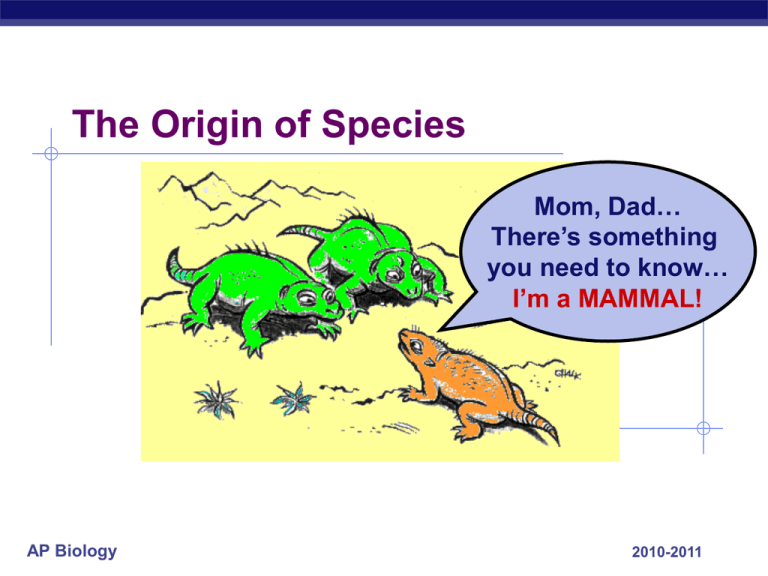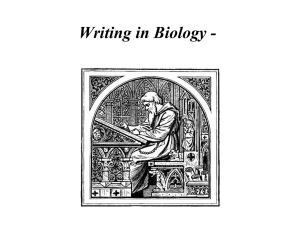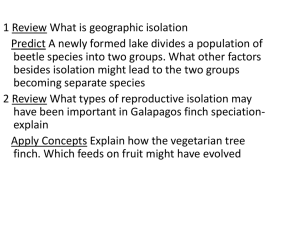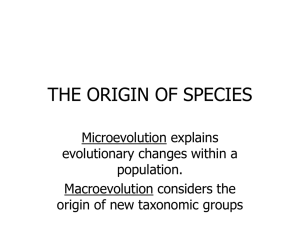
The Origin of Species
Mom, Dad…
There’s something
you need to know…
I’m a MAMMAL!
AP Biology
2010-2011
“That mystery of mysteries…”
Darwin never actually tackled
how new species arose…
Both in space and time,
we seem to be brought
somewhat near to that great fact
—that mystery of mysteries—
the first appearance of
new beings on this Earth.
AP Biology
So…what is a species?
Biological species concept
defined by Ernst Mayr
population whose members can interbreed &
produce viable, fertile offspring
reproductively compatible
Distinct species:
songs & behaviors are different
enough to prevent interbreeding
AP Biology
Eastern Meadowlark Western Meadowlark
How do new species originate?
Populations must become isolated
geographically isolated
reproductively isolated
isolated populations evolve independently
Isolation
allopatric
geographic separation
“other country”
sympatric
still live in same area
“same country”
AP Biology
PRE-reproduction barriers
Obstacle to mating or to fertilization if
mating occurs
geographic isolation
AP Biology
behavioral isolation
ecological isolation
temporal isolation
mechanical isolation
gametic isolation
Ammospermophilus spp
Geographic isolation
Species occur in different areas
physical barrier
allopatric speciation
AP Biology
Harris’s antelope
squirrel inhabits
the canyon’s
south rim (L). Just
a few miles away
on the north rim
(R) lives the
closely related
white-tailed
antelope squirrel
sympatric speciation
Ecological isolation
Species occur in same region, but occupy
different habitats so rarely encounter each other
reproductively isolated
2 species of garter snake, Thamnophis,
occur in same area, but one lives in water &
other is terrestrial
AP Biology
lions & tigers could
hybridize, but they
live in different
habitats:
lions in grasslands
tigers in rainforest
Temporal isolation
Species that breed during different times of day,
different seasons, or different years cannot mix
gametes
reproductive isolation
sympatric speciation
Eastern spotted skunk
(L) & western spotted
skunk (R) overlap in
range but eastern mates
in late winter & western
mates
in late summer
AP Biology
sympatric speciation?
Behavioral isolation
Unique behavioral patterns & rituals isolate species
identifies members of species
attract mates of same species •
courtship rituals, mating calls
reproductive isolation
AP Biology
Blue footed boobies mate
only after a courtship display
unique to their species
Recognizing your
own species
courtship songs of sympatric
species of lacewings
courtship display of
Gray-Crowned Cranes, Kenya
firefly
AP Biology
courtship displays
sympatric speciation?
Mechanical isolation
Morphological differences can prevent
successful mating
reproductive isolation
Even in closely related
species of plants, the
flowers often have distinct
appearances that attract
different pollinators.
These 2 species of monkey
flower differ greatly in
shape & color, therefore
cross-pollination does not
happen.
AP Biology
Plants
Mechanical isolation
Animals
For many insects, male &
female sex organs of
closely related species do
not fit together, preventing
sperm transfer
lack of “fit” between sexual organs:
hard to imagine for us… but a big issue for insects with
different shaped genitals!
I can’t even imagine!
Damsel fly penises
AP Biology
sympatric speciation?
Gametic isolation
Sperm of one species may not be able to fertilize
eggs of another species
mechanisms
biochemical barrier so sperm cannot penetrate egg
receptor recognition: lock & key between egg & sperm
chemical incompatibility
sperm cannot survive in female reproductive tract
Sea urchins release sperm
& eggs into surrounding
waters where they fuse &
form zygotes. Gametes of
different species— red &
purple —are unable to fuse.
AP Biology
POST-reproduction barriers
Prevent hybrid offspring from
developing into a viable, fertile adult
reduced hybrid viability
reduced hybrid fertility
hybrid breakdown
zebroid
AP Biology
sympatric speciation?
Reduced hybrid viability
Genes of different parent species may
interact & impair the hybrid’s development
Species of salamander
genus, Ensatina, may
interbreed, but most
hybrids do not complete
development & those
that do are frail.
AP Biology
Reduced hybrid fertility
Even if hybrids are vigorous
they may be sterile
chromosomes of parents may differ in number
or structure & meiosis in hybrids may fail to
produce normal gametes
Mules are vigorous,
but sterile
Horses have 64
chromosomes
(32
pairs)
AP Biology
Mules have 63 chromosomes!
Donkeys have 62
chromosomes
(31 pairs)
sympatric speciation?
Hybrid breakdown
Hybrids may be fertile & viable in first
generation, but when they mate offspring
are feeble or sterile
In strains of cultivated rice,
hybrids are vigorous but
plants in next generation are
small & sterile.
On
path to separate species.
AP Biology
Rate of Speciation
Does speciation happen gradually or rapidly
Gradualism
Punctuated Equilibrium
gradual
accumulation of
small changes over
long time
rapid bursts of
change mixed with
long periods of
little or no change
AP Biology
Charles Darwin
Charles Lyell
Stephen Jay Gould
Niles Eldredge
Gradualism vs. Punctuated Equilibrium
Gradualism
gradual divergence over long spans of time
assume that big changes occur as the
accumulation of many small ones
Punctuated Equilibrium
rapid bursts of change
long periods of little or no change
species undergo rapid change when they
1st bud from parent population
AP Biology
Stephen Jay Gould
Niles Eldredge
Life can change quickly…
Ask Questions!
AP Biology
2010-2011












